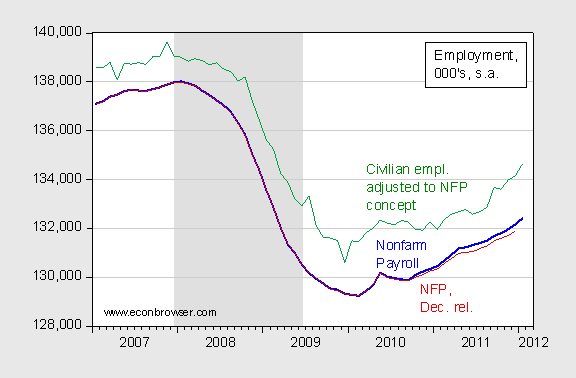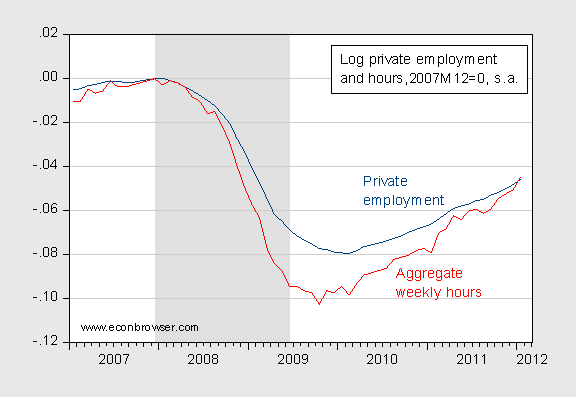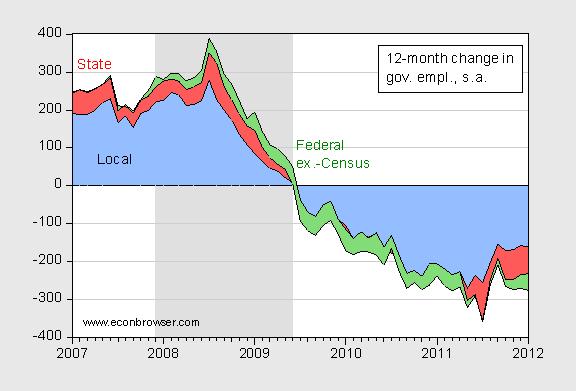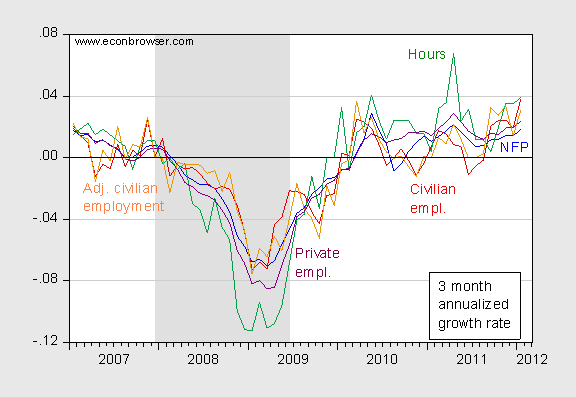Employment growth accelerates along several dimensions: nonfarm payroll, an alternative measure of nonfarm payroll, private employment, hours, and civilian employment (report here). However, JEC vice chairman Brady (JEC-Republicans) states in a press release: “Job Numbers Mask Underlying Job Weakness.”

Figure 1: Nonfarm payroll employment from January release (blue), and from December release (dark red), and civilian employment adjusted to conform to NFP concept (green), 000’s, seasonally adjusted. NBER defined recession dates shaded gray. Source: BLS via FRED, BLS, and NBER.
Not only did NFP employment increase by 243,000, benchmark revisions going back four years (although important revisions were for the last year) raised the December 2011 estimated employment by 266,000. Trend employment continued to rise. This upward shift was also reflected in the research series that is calculated by using household data to generate a series conforming to the NFP concept; the changes are largely due to the application of new population controls (see BLS, Appendix). More on the distinction between the official and research series at here.
With the government shedding jobs, it is perhaps more useful to refer to private employment for underlying labor market trends.

Figure 2: Log private employment (dark blue), and log aggregate weekly hours index in private sector, series AWHI (red), seasonally adjusted, rescaled to 2007M12=0. NBER defined recession dates shaded gray. Source: BLS via FRED, NBER and author’s calculations.
Aggregate weekly hours continue to grow more rapidly than employment; by January, aggregate hours had regained ground such that both employment and hours are now about 4.5% below peak (2007M12) levels.
While private employment continues to grow, government employment continues to fall; the decline is most pronounced at the state and local level (Wisconsin is a good example of the contractionary impact of such measures [1] [2]). However, civilian Federal government employment is also declining.

Figure 3: Twelve month change in government local employment (blue), in state employment (red), and government employment ex.-temporary Census workers (geen), 000’s, seasonally adjusted. NBER defined recession dates shaded gray. Source: BLS via FRED, NBER and author’s calculations.
Finally, it’s useful to examine the trends in multiple labor market series as once. Figure 4 presents one view.

Figure 4: Three month annualized growth rates in nonfarm payroll employment (blue), in civilian employment (red), private sector employment (purple), private sector hours (green), and civilian employment adjusted to conform to NFP concept (orange), all calculated as 3 month log differences, seasonally adjusted. NBER defined recession dates shaded gray. Source: BLS via FRED, BLS, NBER and author’s calculations.
So, for now the trend is positive, but there are clouds on the horizon [Madigan/WSJ RTE]. For more coverage, see [Rampell/Economix] Norris/Economix] [Lahart/WSJ RTE] [Evans/WSJ RTE] [Free Exchange] [Tim Duy] [CR]. A roundup of economist views available from [Izzo/WSJ RTE].
Despite improvement in the labor market, it is clear more needs to be done to accelerate closing the output gap. JEC vice chairman Brady (R) argues:
…It’s time to change course away from higher deficits and higher taxes that are creating fewer jobs and lower expectations for America. Instead, we need to restore confidence by businesses on Main Street to make the new investments in buildings, equipment, and software to create millions of jobs.
Brady and House Republicans continue to push for a balanced budget, fairer tax code, more balanced regulation and reforms to make Social Security and Medicare solvent for the long term.
This perspective shares intellectual lineage with the underpinnings of the Ryan plan, examined here the JEC expansionary contractionary fiscal scenario here. An examination of the other propositions of equal empirical deficiency — regulation reduction and growth, and regulatory uncertainty reduction and growth — examined here and here, respectively.
In my opinion, Representative Brady’s prescriptions will, like the contractionary fiscal policies implemented in Wisconsin [3] [4], reverse rather enhance the employment recovery seen thus far [5] (i.e., textbook macro applies).
Update, 1:40pm 2/5: For more considered analysis of how to sustain momentum, tune in to JEC’s hearings on extending the payroll tax cut (and for JEC-Democrat’s analyses, see here and here).
When we scrape away the happy horseshit by economists like Chinn who get paid by the top 1% to tell us “it isn’t different this time” and everything will turn up roses in the economy by and by, if only we wait for it, we get a drastically different picture.
“There are two facts to deal with in this Great Recession. The labor force hasn’t grown since December 2007 when the recession started, even though we are a much bigger country. The “Not in Labor Force” has increased in response. This must mean that the labor-force participation rate has declined. Let’s graph each normalized to December 2007.
“The second, as Arjun Jayadev and I explained back when, is that this is the first time period we have data for where it is more likely an unemployed person will drop out of the labor force rather than find a job. A lot of the increase in the number of those outside the labor force is the unemployed giving up on work. Both of these tell us that there is something fishy going on with traditional unemployment figures that just count the unemployed.”
Source: “What is the Real Unemployment Rate, and How Could We Tell?” at rortybomb.wordpress.com.
Chinn and the rest of the paid corporate flunkies will retort that discussion of a “real” unemployment rate is futile since not only the measurement methods but the underlying structure of the U.S. economy has changed since the last time we had an economic downturn this big (in the Great Depression a far larger proportion of Americans worked on farms), and in any case measures of total proportion of the population who work don’t track to economic growth or per capita GDP, since the German economy remains dynamic and is growing strongly with high per-capita GDP, yet a much lower proportion of the German labor works than in harder-working but less prosperous economies like Italy.
Both these points are bogus. We’re not talking about different economies here but the same economy over a 20-year-period, so the fact that the proportion of the people in U.S. labor force has plummeted since the 1990s actually tells us something meaningful and dire about the U.S. economy. The fact that the premium for a bachelor’s degree started to drop like a rock in the U.S. in 1997 should also send us some warning signs.
`Nothing Mr Obama has been able to accomplish since 2008 – including staving off a second Great Depression and pushing through an overhaul of the healthcare system – appears to have resolved that underlying structural challenge. Indeed, the signs are that the problem is intensifying. In the words of David Autor, a leading labour economist at Harvard University, the labour force is suffering from a growing “missing middle”.
`In short, the middle-skilled jobs that once formed the ballast of the world’s wealthiest middle class are disappearing. They are being supplanted by relatively low-skilled (and low-paid) jobs that cannot be replaced either by new technology or by offshoring – such as home nursing and landscape gardening. Jobs are also being created for the highly skilled, notably in science, engineering and management.
`For the remainder of the workforce, including college graduates, it is both increasingly hard to find a secure job and tougher for those who do find jobs to be paid in line with inflation. Most people know that median US income has declined sharply since the late 1990s. Fewer are aware that real incomes also fell sharply in the same period for those with degrees. Only those with postgraduate qualifications, particularly PhDs, saw net gains (for some spectacular).
`The jobs crisis has many worrying manifestations, of which three are worth highlighting. Perhaps the most troublesome is the waning dynamism of the market. People used to describe the US labour market as Schumpeterian, after the Austrian neoclassical economist who depicted the cycle of “creative destruction”. Jobs might be lost rapidly in a downturn but were swiftly reallocated to more productive sectors when economic growth resumed. That is not now the case.
`According to McKinsey, the consultancy, it took six months for the US economy to recover its pre-recession jobs level after the 1982 downturn. Following the 1991 recession, that had risen to 15 months. After 2001, it took 39 months – meaning that the economy required almost the full business cycle to regain the jobs total bequeathed by the previous one. Following the Great Recession of 2008, McKinsey forecast that the economy would take 60 months to reach the pre-downturn jobs level.
`That now looks optimistic. In December 2007, the US economy employed 146m people. Four years later, it languishes at 140m. At the current rate of job creation it will take another two and a half years to regain 2007 levels – taking the replacement cycle to as much as 78 months. This is destruction minus the creativity. Even that understates the problem, since in that time the population will have risen by more than 10m.
`“I know companies that employ senior engineers whose only job is to find ways to reduce the headcount,” says Carl Camden, chief executive of Kelly Services, a booming staffing agency based in Michigan. “The name of the game everywhere is to reduce permanent headcount and we are still only at the early stages of this trend.”
`The second problem stems from the first – America is employing a decreasing proportion of its people. At the start of the recession, the employment-to-population rate was 62.7 per cent. The rate is now 58.5 per cent. Last month, unemployment fell from 9 per cent to 8.6 per cent. On the surface, this looked like a welcome leap in job creation. In reality, more than half of the fall was accounted for by a decrease in the numbers “actively seeking” work. The 315,000 who dropped out of the labour market far exceeded the 120,000 new jobs.
`How many electricians does it take to change a lightbulb? None. They are too busy emptying your bedpan.
`(..) Finally, a growing share of whatever jobs the economy is still managing to create is in the least productive areas. Of the five occupations forecast by the Bureau of Labor Statistics to be the fastest growing between now and 2018, none requires a degree. These are registered nurses, “home health aides”, customer service representatives, food preparation workers and “personal home care aides”.
`Manufacturing is nowhere in the top 20, and such jobs cannot replace the pay and conditions once typical of that sector. “The food preparation industry cannot sustain a middle class,” says Dan DiMicco, chief executive of Nucor, one of America’s two remaining big steel companies, whose company motto is “a nation that builds and makes things”.
`The tides are not with Mr DiMicco. According to a study this year by Michael Spence, a Nobel Prize-winning economist from Stanford University, and Sandile Hlatshwayo, all net job creation since 1990 has been in the “non-tradable sector”. Between 1990 and 2008, the US added 27.3m jobs, of which almost every one was in services. Almost half were in healthcare or the public sector – both areas in which productivity growth is virtually zero. Conversely, manufacturing’s impressive productivity growth has tracked its shrinking headcount.
`If there is an explanation as to why middle-class incomes have stagnated in the past generation, this is it: whatever jobs the US is able to create are in the least efficient sectors – the types that neither computers nor China have yet found a way of eliminating. That trend is starting to lap at the feet of more highly educated American workers. And, as the shift continues, higher-paying jobs are also increasingly at risk, argue Prof Spence and Ms Hlatshwayo.’
Source: “Can America regain most dynamic labor market mantle?” Edward Luce, Financial Times, December 2011. (It’s behind an annoying registration wall. You can get to the article by searching for it via google news.)
Looks like some nice momentum building, but weather certainly played a role. Much of the U.S. experienced a relatively mild December and January, so some jobs were pulled into January from March and April. Weather probably played a larger role in motivating some of the half million people who were ‘out of the labor force’ to begin looking for work and become reclassified as unemployed or employed. Hopefully, the weather effect was small and the momentum will continue.
mclaren: And here I thought I was being paid by the taxpayers ( less than 18%) and tuition-paying students of Wisconsin. Silly me!
By the way, in many previous posts, I have stressed the likely slow growth of economic activity in the wake of the great recession (e.g., [a]).
Chinn re mclaren:I was flattered that we economists warranted our own Occupy movement at Chicago.
But to have your own personal “Occupy Menzie Chinn” movement — wow! even if it does seem to be a one person show…
From where I sit, the increase in payroll employment over the last two years has been equal to the increase in the potential workforce from kids coming out school: about 1.8 million kids/year (assuming 65% workforce participation)…. In other words- were only treading water after $1.6 Trillion in Federal Reserve balance sheet expansion, about $2.7 Trillion in Federal deficit spending, and over $0.9 Trillion in Current Account Deficits in the last two year period. We are in serious trouble. Until the US stops importing more than we export, we will continue to box up our factories and technology and ship it overseas to pay our debts, exacerbating unemployment and financial stability. We have to stop grasping at straws and deal with the disease- FRAUDULENT LIQUIDITY and FRAUDULENT FINANCIAL ASSETS.
mcclaren Much of your rant is just unhinged and not worth the bother of reading much less commenting upon. But this issue of structural job market problems is, I think, a valid concern. It was also a valid concern long before the Great Recession hit and I suspect it will continue to be a concern long after economic recovery. What’s wrong with your post is that you are confusing two different problems. The immediate problem, and the one that we know government action can fix, is the problem of cyclical unemployment due to slack aggregate demand in the economy. And clearly the economy seems to be making some improvements along those lines despite the best efforts of Republicans like Rep. Brady to frustrate that improvement. Unlike Sen. McConnell, I don’t think Rep. Brady is deliberately plotting to stall the recovery; he’s just another one of those hapless and not-too-bright Tea Party types that the state of Texas seems to spawn the way cockroaches spawn around open drain pipes. [Note: As a twentysomething I lived in Texas for awhile.] Solving structural employment issues is not something that we should be demanding of Obama right now. That’s a much longer term project.
MarkS To a first approximation it’s the change in the deficit that has a stimulative effect on aggregate demand and not the level of the deficit. We entered the recession with a pretty good sized structural deficit already. Simply maintaining that structural deficit does not add any new stimulus to the economy. But shrinking the deficit does make things contractionary.
The capital city is departing from the production and manufacturing, fortune are self and auto generating through their own substance,the speculation in commodities and lands are a great source of wealth.Proconsul jobs are a gold mine, managing for and account of the republic of Rome the vast agricultural foreign lands ,mineral resources and fiscal taxable resources a material personal reward .The trading,the financial only sources of incomes are slowly driving the manufacturing resources to nil,to be a broker the best qualification.”Only the small bourgeois class, out of Rome is still believing in the virtues of work and wages for work”,Meanwhile the society is in the recognition of its divide, where the wealth is according to Martial (1st century)estimated in the assets book value of the loans and the worthiness of the debtors (yes assets prices marked to market).
The same little bourgeois with annual expenses of less than 20.000 sertesses could not match the millions of sertesses that senators and proconsuls belonging to the splendid order of the “clarissimes’ could expense.The unemployment is high 1/3 of the population of Rome in its larger circle, depend upon charity.According to the same Martial account 700.000 persons in Rome only.
J. Carpocino “La vie quotidienne à Rome”
While I agree that the economy is iopvmring, my concern is that it is only a mini bull market within the context of a huge long term secular bear market.With all the money the Fed and government has thrown at the economy its bound to react to it. The so called recovery in the stock market the last 6 months is just that reacting to an iopvmring economy ..not a cured economy.But will it be long lasting? I don’t think so. We don’t have the real wealth generating type of economy of years ago ..thus the so called jobless recovery. We have too much of a services and consumption economy. Too much of GDP is attributed to consumption, and not real wealth generating. The government going into debt like it is will not cure anything but only delay the day of reckoning.The Federal Reserve’s answer to the economic problems since the 70 s has been to stimulate the economy via enticement to borrow money and spend in the economy. This has resulted in these constant business cycles of recession and ever lower interest rates. They never can get the rate of interest back to the previous high. Thus the whole interest rate structure is sinking to 0% from its peak in 1981.There is no more room to stimulate the economy other than unconventional means or quantitative easing. I believe the Federal Reserve has reached the end of its capability other than printing money which would destroy the currency and its power. So I think the next crises cycle, which will probably be sooner than most economist think, and will be worse than this one.Afterall, Greenspan’s answer to the tech stock, dot-com and Nasdaq bust was to stimulate consumption through lower rates. What good did it do? Well it did create an improved economy from 2003 thru 2007 but that was only because of the real estate and consumption (debt) bubbles.Now the financial side of our economy is paying for this. When an economy has come to rely on credit for growth like it has for decades and you have the kind of financial crises we’ve just had, I don’t think it recovers very easily and likely will not be a V-Recovery like 2001 recession.These are the kind of scenarios that great depressions are made of and just perhaps we’re only in year 2 of it. From an Austrian economic viewpoint (not Keynesian), what the government is doing by going into debt to substitute for the loss of consumer spending will not cure our problems.Thus it is to be expected there will be a worse recession down the road even if we do have a mini-recovery right now.
Mclaren, I won’t hold back on being abrasive, because I couldn’t top you; your entire post can pretty much be written off as completely illogical, and frankly bullshit. When you aren’t pulling some trite platitude about dear Menzie (the public university educator) being some corporate mouthpiece or 1%’er out of a unicorn’s rectum, you’re resting your point on a blatant fallacy to make your point for you. Both of which are wholly incorrect, therefore can be referred to as illogical bullshit. QED.
I think this is somewhat reinforced by your utter reliance on other peoples words to do the talking for you– presumably not content with merely parroting the arguments of actual intellectuals.
Such a pity.